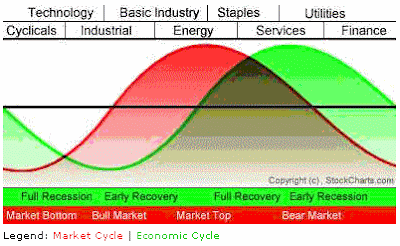Basics of Sector Rotation
As always, please consider a subscription to BigTrends.
-- David M Gordon / The Deipnosophist
~~~~~~~~~~~~~~~~~~~~~~~~~~~~~~~

February 12, 2009
Basics of Sector Rotation
Investors are always looking for the next "big thing" in trading, the best way to get that specific edge, a way to turn a struggling portfolio around or augment a successful trading theory. One such strategy is the Sector Rotation strategy. This trading philosophy is based on sectors and exchange-traded funds (ETFs), which are one of the more popular trading vehicles in today's market. When utilizing the sector rotation strategy, the trader is making a long-term commitment, but also a commitment to be fluid in your management style.
The Basics
Let's start with the strategy. A basic sector rotation strategy contends that the economy runs cyclically - up sometimes, lower other times. This idea was presented by Sam Stovall in his 1996 book, Sector Investing (which is why many call this the Stovall Rotational Strategy). The key is to identify the cycles, buying at the lows and selling at the highs. Success is based on timing, which is why Stovall presented four stages for the economy and for markets.
First, the economic cycle:
1. full-blown recession
2. early recovery
3. late recovery
4. early recession
Next you have the market cycle:
1. market bottom - prices drop
2. bull market - the market rallies
3. market top - the market hits a top and flattens out
4. bear market - prelude to the next market bottom, the market falls
The Model
With an economy that runs in cycles, one needs to understand that there will be sectors that lead and lag the cycles. This need leads to investors trying to anticipate the economic impact of the economic cycle. This anticipation causes the market cycle to proceed the economic cycle.
Confused? Perhaps, but don't fret. The kind folks at StockCharts.com have a widely used sector rotation model, which is included for you below.
 The red wave is the market cycle and the green wave is the economic cycle. Across the top of the chart are the sectors into which Stovall divided the economy: technology, basic industry, staples, utilities, cyclicals industrial, energy, services, and finance.
The red wave is the market cycle and the green wave is the economic cycle. Across the top of the chart are the sectors into which Stovall divided the economy: technology, basic industry, staples, utilities, cyclicals industrial, energy, services, and finance.As you can see by the model, certain sectors perform well at different stages of the economic cycle. As an example, cyclicals perform well near the beginning of a recession, tech performs well during the recession, and industrials perform well near the end. Since recession is followed by early recovery, industrials see their solid performance carry over to the beginning of the early recovery portion of the cycle.
What Does This Mean for 2009?
Really, it depends on what portion of the economic cycle you believe we are slogging our way through. If you believe we are in the early recession portion of the cycle, you will want to look at services, utilities, and cyclicals. However, if you believe we are moving through the full recession, keep an eye on the aforementioned cyclicals, technology, and industrials.
As noted in the opening of this piece, a commitment to the sector rotation is a commitment to fluid investing. Remember that the key to this strategy is timing, timing, and timing.
Trade Well,
BigTrends Research
Labels: Chart analysis, Lessons, Market analyses, Referrals - websites






































































































<< Home